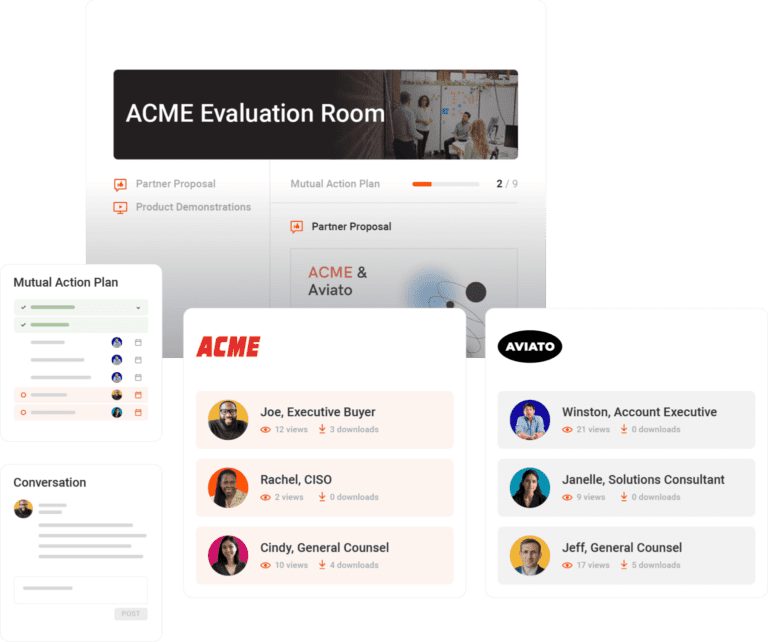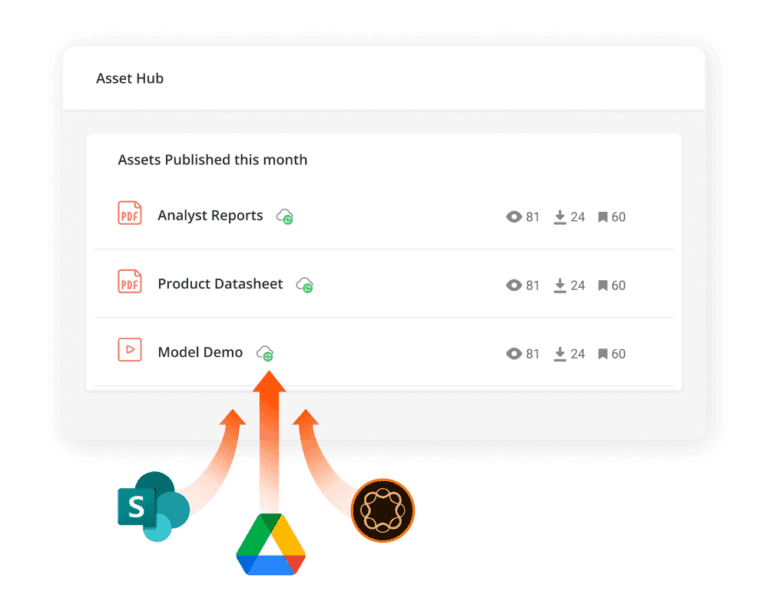As a sales enablement leader, sales content is a big part of your job. Whether it’s creating it, training reps on it, monitoring its performance, or updating it, simplifying sales content management lets sales enablement leaders focus on other programs that help sellers actually sell.
When sales content hits the mark with both sellers and buyers, it can be a powerful tool for advancing deals forward. Our 2023 State of Sales Productivity Report found that interactions with content per rep per week doubled last year. It went from 3.5 interactions per week in 2021 to 7.5 in 2022.
But when sales content doesn’t hit the mark, it can disengage your audiences and stall deals. According to Sales Enablement Collective’s 2022 Sales Enablement Landscape Report, 63.1% of respondents said sales content wasn’t as good as needed.
According to the Sales Enablement Collective
So how do you create a sales content management strategy that’s simple, personalized, and scalable? In this blog post, we’ll walk you through:
- What is sales content management?
- The importance of sales content management
- What are the benefits of sales content management?
- Improves sales and revenue productivity
- Reducing sales’ search time for content and collateral
- Increasing win rates
- Improving sales and marketing alignment
- Improving the ability to track content usage
- Reducing new sales team members’ ramp times
- Reducing competitive losses
- How to improve sales content management with technology solutions
What is sales content management?
Sales content management refers to the process of creating, organizing, distributing, and analyzing sales-related content, such as product information, case studies, and customer testimonials, with the goal of supporting the sales team and improving their performance.
Effective sales content management involves developing a content strategy that aligns with the organization’s overall sales goals and targets specific stages of the sales cycle. It also involves selecting the right tools and technologies to manage the content, such as a content management system (CMS) or a customer relationship management (CRM) system.
Sales content management can help sales teams to:
Access the right content
Customize content
Track peformance
- Access the right content at the right time: By organizing and centralizing sales content, sales reps can easily find the information they need to educate prospects and move them through the sales funnel.
- Customize content for different audiences: Sales teams can tailor content to meet the specific needs of their target audiences and increase their chances of closing a deal.
- Track content performance: By analyzing the performance of sales content, sales managers can identify what’s working and what’s not, and adjust their strategies accordingly.
Overall, sales content management is a critical part of any sales strategy, helping organizations to improve their sales performance and grow their business.
The importance of sales content management
Sales content management is essential for organizations that want to improve their sales performance and drive revenue growth. Here are some key reasons why sales content management is important:
Sales content management helps to ensure that sales reps have access to the most up-to-date and accurate content. This helps to ensure consistency in messaging across the organization, which can build trust with prospects and customers.
Sales reps spend a lot of time searching for content, and this can be a drain on productivity. By using sales content management tools, sales reps can easily find the content they need and focus on selling, rather than on administrative tasks.
Sales content management tools enable sales reps to customize content for individual prospects or customers, based on their specific needs and interests. This can help to build stronger relationships and increase the likelihood of closing a sale.
Sales content management tools provide insights into which content is resonating with prospects and customers, and which is not. This can help sales managers to make data-driven decisions about which content to prioritize, and to identify areas where sales reps may need additional sales training or support.
As organizations grow, it becomes increasingly difficult to manage sales content manually. Sales content management tools can help to scale content creation and distribution, enabling organizations to reach more prospects and customers without sacrificing quality.
Sales content management is critical for organizations that want to improve their sales performance, build stronger customer relationships, and drive revenue growth. By using the right tools and strategies, organizations can streamline content management and make their sales teams more effective and efficient.
What are the benefits of sales content management?
CSO Insights asked 16.5% of participants who actually use a sales enablement platform to share the top three benefits they received from such a system. Below is a chart that summarizes the results:
Let’s take a look at some of the improvements in sales performance experienced by these companies.
Improves sales and revenue productivity
Sales content can be crucial in improving sales and revenue productivity in several ways. Here are some examples:
Well-crafted sales content, such as case studies, product information sheets, and customer testimonials, can help educate prospects about the benefits of a product or service, and help them make more informed purchasing decisions. By providing relevant information that addresses their needs and pain points, sales content can help to build trust and credibility, which can ultimately lead to more sales.
Sales content can be customized to meet the specific needs of individual prospects or customers. This can be achieved by segmenting the audience based on factors such as industry, company size, or job title, and tailoring content accordingly. Personalized sales content can help to build stronger relationships with prospects and customers, and increase the likelihood of closing a sale.
Consistent messaging across all sales content can help to build brand awareness and recognition. By using a consistent voice and tone, and conveying a clear value proposition, sales content can help to differentiate a company from its competitors and position it as a thought leader in its industry.
Sales content can help to streamline the sales process, enabling sales reps to more efficiently move prospects through the sales funnel. By providing sales reps with the right content at the right time, sales content can help to reduce the amount of time spent searching for information and enable sales reps to focus on selling.
Sales content can be analyzed to gain insights into what content is resonating with prospects and customers, and what is not. This information can be used to optimize sales content, and to identify areas where sales reps may need additional training or support. By using data to drive decisions about sales content, organizations can increase the effectiveness of their sales teams and drive revenue growth.
Sales content improves sales and revenue productivity by educating prospects, personalizing content, providing consistent messaging, streamlining the sales process, and using data to optimize content and identify areas for improvement. By investing in sales content management and creating high-quality sales content, organizations can increase their sales effectiveness and achieve their revenue goals.
Reducing sales’ search time for content and collateral
These two improvements are closely related. When your salesforce has easy access to sales content and tools, their search time is reduced. These two outcomes alone increase the amount of selling time that your reps have and increase their overall productivity. Here’s how.
Increasing win rates
Good sales content can help you close more deals in several ways:
Good sales content is created with the buyer’s journey in mind. It should provide information that is relevant to the prospect’s specific stage in the buying process. By providing the right information at the right time, sales reps can build trust and credibility with the prospect, and move them closer to making a purchasing decision.
Sales content should address common objections that prospects may have, and provide persuasive arguments to overcome these objections. By anticipating objections and providing solutions, sales reps can reduce the likelihood that a prospect will back out of a deal.
Good sales content should highlight the unique benefits of your offering and differentiate it from your competitors. By providing clear and compelling reasons why your product or service is the best choice, sales reps can increase the likelihood that a prospect will choose to do business with you
Good sales content can facilitate conversations between the sales rep and the prospect. It can provide a starting point for discussions, and help the sales rep to better understand the prospect’s needs and pain points. By having more productive conversations, sales reps can build stronger relationships with prospects and increase the likelihood of closing a deal.
Good sales content should provide value beyond the sale. It should help the prospect to better understand the product or service, and provide guidance on how to get the most out of it. By providing ongoing value, sales reps can build stronger relationships with customers, increase customer satisfaction, and drive repeat business.
By investing in sales content management and creating high-quality sales content, organizations can increase their sales effectiveness and achieve their revenue goals.
Improving sales and marketing alignment
Sales and marketing departments worked separately for many years. More recently, they’ve made more efforts to communicate more consistently. Doing so allows Marketing to continually deepen their understanding of your prospects. This makes it easier for them to create content that encourages prospects to move through their buying cycle. In fact, according to a DemandGen study, over half of the participants estimated a revenue increase of 20% if they had the right content available at the right time in the sales cycle.
Reducing new sales team members’ ramp times
New rep ramp time varies from company to company. Average sales cycle length and training effectiveness influence the amount of time it takes for a new salesperson to become fully productive. Reducing this time increases your bottom line more quickly as well. Having content more easily distributed and accessible means that new reps are able to learn more in a shorter period of time. Having content at their fingertips helps reps sell more effectively without needing to memorize every proof point. All they have to do is find it, consume it, and/or share it with their prospect. Their questions are answered without slowing down in the learning and sales processes.
Improving the ability to track content usage
Tracking content usage provides valuable insights into marketing’s effectiveness. It enables them to know which content is being used more frequently and which content isn’t being used at all. This information allows them to quickly and easily identify content gaps so they’re able to stay current with new content requirements. This results in sales always having the content they need throughout the sales cycle for the exact persona in the specific industry.
Reducing competitive losses
Good sales content can be a powerful tool in winning over your competition. Here are some ways it can help:
- Differentiation: Good sales content can help you differentiate your product or service from your competitors. By highlighting your unique value proposition and explaining why your offering is better than your competitors, you can give potential customers a reason to choose you over your competition.
- Education: By providing informative and educational content, you can position yourself as an expert in your field. This can help build trust with potential customers and give them confidence that you have the knowledge and expertise to meet their needs.
- Persuasion: Effective sales content can persuade potential customers to take action. By addressing their pain points and showing them how your product or service can solve their problems, you can motivate them to choose your offering over your competitors.
- Credibility: Good sales content can also help establish your credibility and reputation in the marketplace. By providing case studies, testimonials, and other social proof, you can show potential customers that you have a track record of delivering results and providing value.
Overall, good sales content can help you stand out from your competition, educate and persuade potential customers, and build your credibility and reputation in the marketplace.
How to improve sales content management with technology
There’s no shortage of ways to organize, distribute, and measure sales content. Scaling and simplifying sales content efforts gets its power when it’s embedded into other enablement efforts.
At Mindtickle, we know that content needs to be aligned with skills, processes, and customer needs.
Here’s how we’re doing it.
Mindtickle’s Digital Sales Rooms are much more than simple content microsites and elevate the digital sales experience. They are collaborative portals where the entire selling team and all buyer stakeholders can align, communicate, share content, and drive the deal to its optimal resolution.

Automatic content sync allows you to use more content more easily, by automatically syncing content and metadata from your cloud-based content storage directly into Mindtickle.

Enablement engagement metrics provide granular engagement analytics that expose how learners engage with content. Dashboards and reports give visibility into the impact of your efforts and inform your strategy with smarter data.
Customized, quick content sharing protects your brand and ensures the right messaging reaches the market. At the same time, sellers have the agility and flexibility they need to build smart, custom presentations. Sellers can tailor the buying experience to each buyer’s needs.
Smart content attribution & revenue impact data help you identify the content that actually wins deals. In Mindtickle you can see which content drives revenue impact, and leverage those insights to create better content in the future.
Sales Content Management in Mindtickle
Are you looking to make sales content management more scalable at your org?
Request a DemoThis post was originally published in May 2018, was updated in April 2023, and again in March 2024.


 By Poornima Mohandas
By Poornima Mohandas
